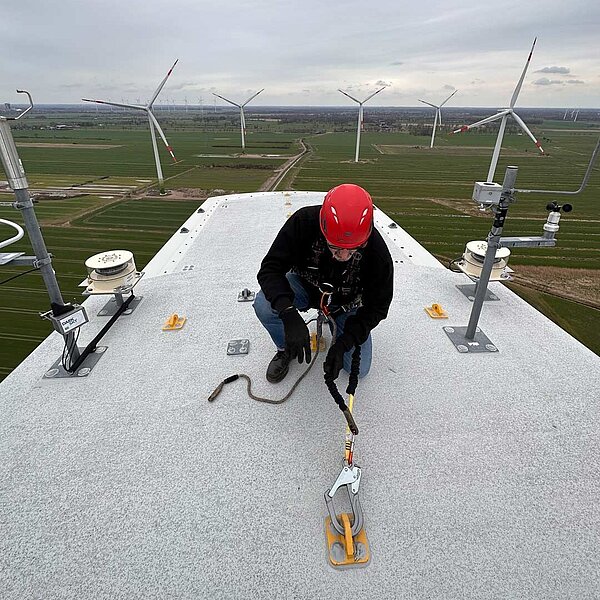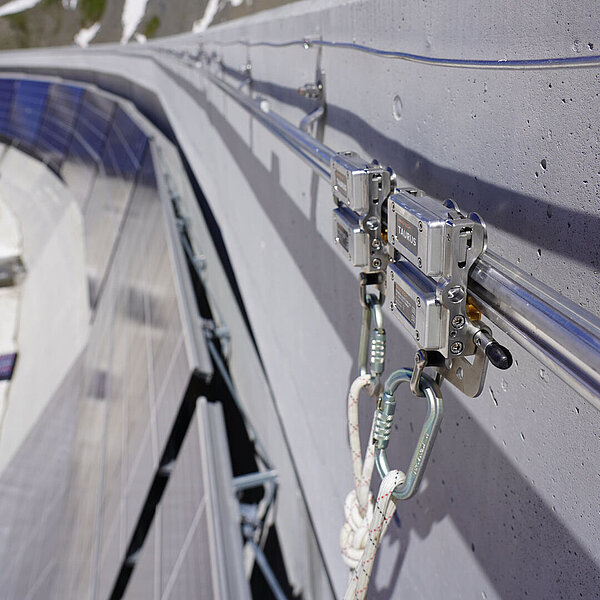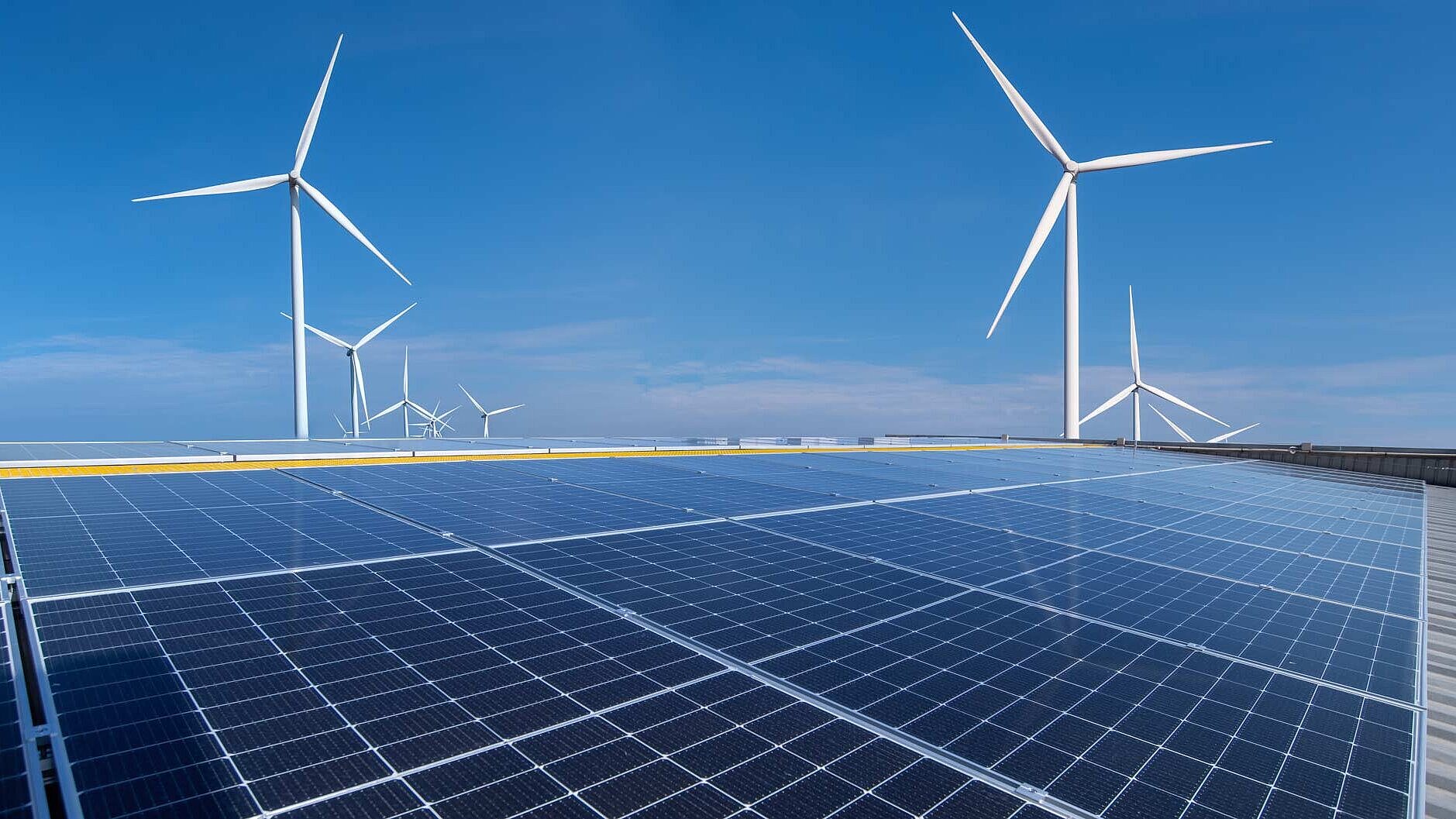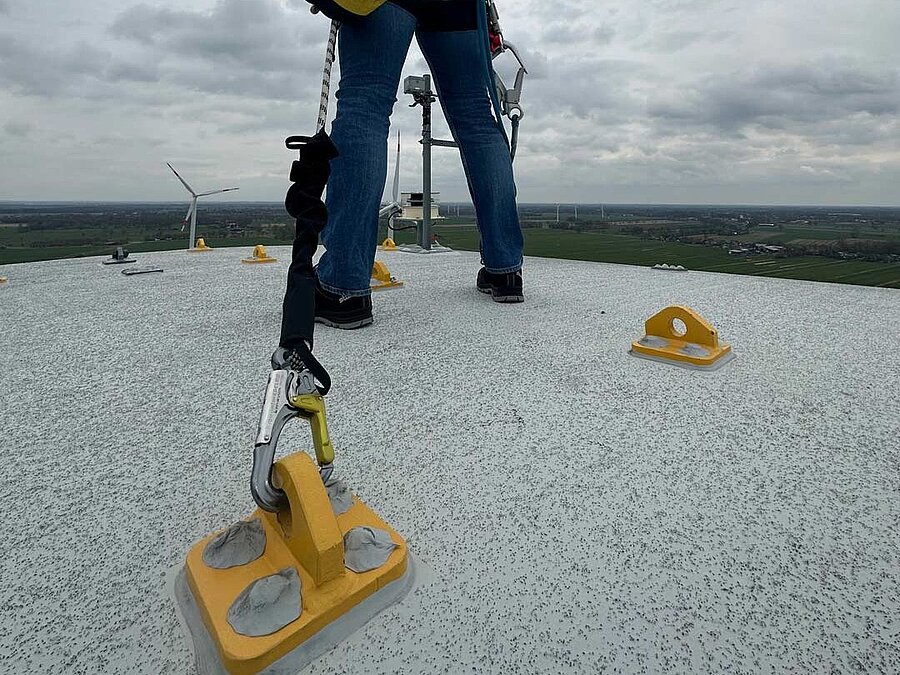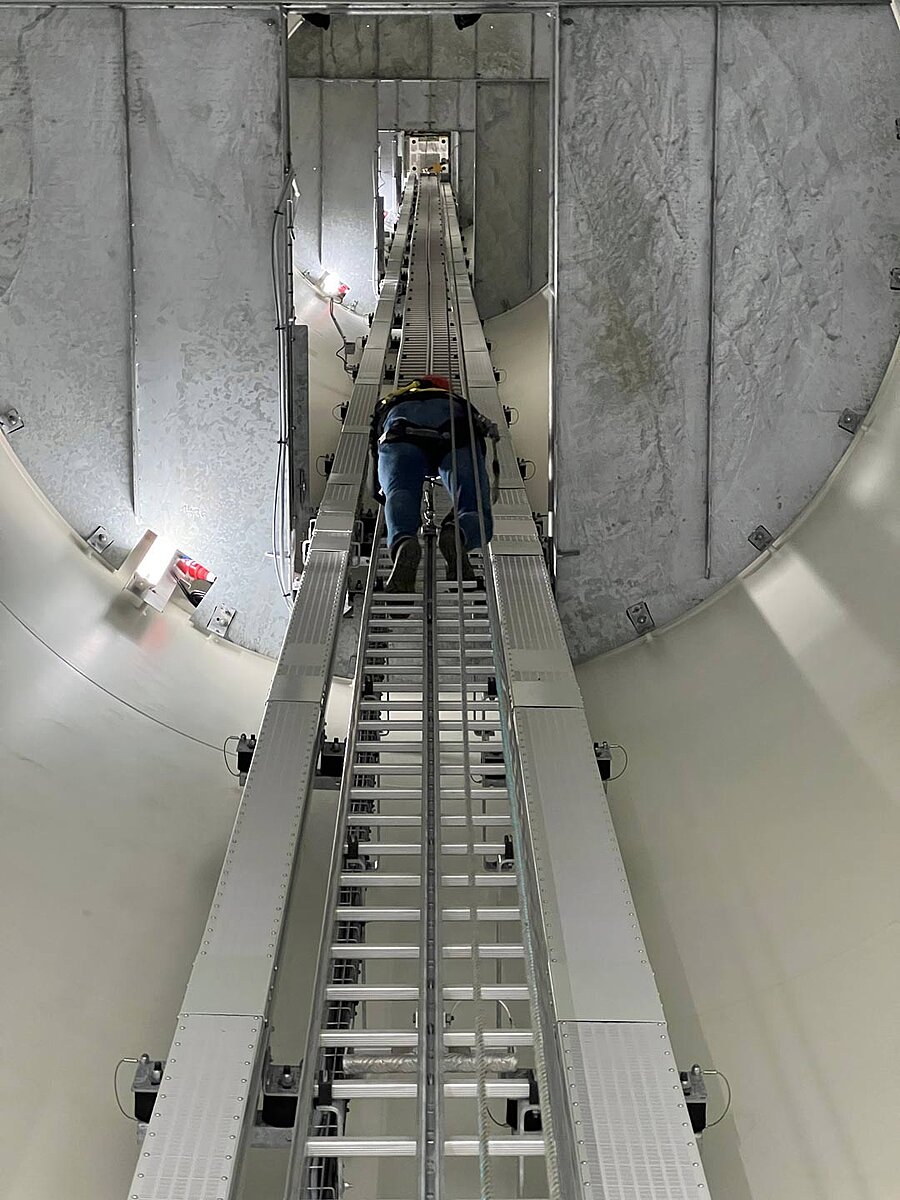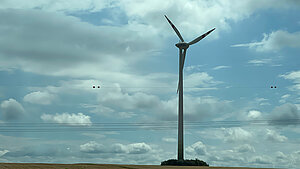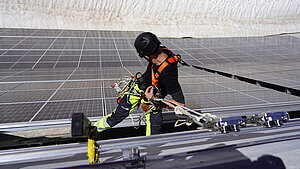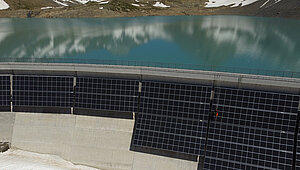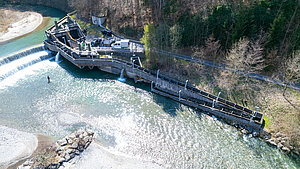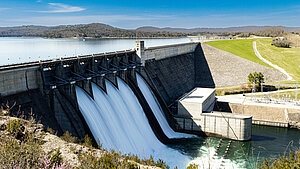Maintenance and service tasks arise not only for old equipment, but also at regular intervals for all wind, water and solar power plants. In the end, it always comes down to ensuring maximum energy output. And that happens only when, for example, the solar panels are cleaned repeatedly, and maximum power is output from the turbines of water and hubs of wind power plants.
However, these workplaces are amongst those with the greatest potential risk for the employees, who simply have to move safely either at dizzying heights or under adverse conditions, in order to maintain the energy generation at its top level.
In terms of falls from height, the danger sources and potentials differ greatly between the three major “green energy” generation systems (wind power, photovoltaics and water power). For this reason, the fall protection systems must be optimally adapted to the requirements of the respective power plant.
Enormous challenge for wind turbines
For wind turbines, the distinctive characteristic for equipment against falls from height is that immense heights, distributed over multiple levels, need to be continuously protected. From steps at the front of or inside the tower, to ladders many metres long, as well as lifts and platforms, to protecting exits and tasks on the hub and rotor blades, the dangers are always different.
In outdoor areas, maintenance tasks are accompanied by strong winds which make the undertaking even more difficult and dangerous. It is indisputable that dramatic falls from the great heights on wind turbine towers must be prevented.
Tower access and ascent
Access to the tower and ascent within it are frequently achieved by using vertical ladders or lifts. Ladders are protected using vertical rail or lifeline systems. Here, workers must wear personal protective equipment against falls from a height (anti-fall PPE), and must use appropriate sliders or carabiners to attach themselves to the anchorage devices. Thus protected, the physically demanding ascent and exit is made.
Guardrails can be installed as collective protection on intermediate platforms, where maintenance tasks are also performed. If there is a changeover from individual protection by means of anti-fall PPE to collective protection, then this should take place seamlessly. It is also essential to wear helmets, as objects may fall down from above. Staircase systems should be well illuminated and slip-resistant. The exit from the gondola to the platform must also be appropriately secured.
A comprehensive safety system is user-friendly in its practical implementation, so it reduces incorrect usage and therefore the risk of falling from height.
Working on the hub and rotor blades
In contrast to the interior, which on wind turbines is protected from the weather, maintenance tasks in outdoor areas hold other dangers in turn, and require special safety measures. The route to the hub must be appropriately protected, for example by a guardrail system or a special cable or rail system, including the associated anti-fall PPE. A fall from this height would have fatal consequences.
The rotor blades also require regular inspection, and possibly repair. For this, it may be necessary to use rope access technology when performing tasks. Accordingly, fall protection systems should be designed and certified for abseiling. Safety nets can be used as an additional safety measure. Throughout the duration of the maintenance tasks on the hub and rotor blades, the wind turbine must naturally be taken out of use, because the moving parts would otherwise represent a further safety risk.

TAURUS VERTICAL
Rail system for vertical use

TAURUS-HORIZONTAL
Rail system for horizontal use

BARRIER-ATTIKA
Guardrail system installed on parapet
Photovoltaics: Challenges with multi-purpose functional surfaces on a roof
The integration of photovoltaic equipment on roofs presents a range of challenges, especially with regard to the safety of the workers while they perform installation and servicing tasks, and in terms of fall-through protection for building components, and the risks from various fall edges in general.
Since the trend towards photovoltaics, the roof has functioned as a surface, although it was never previously used to this extent. Because of this, PV installations now compete with other equipment on the roof, such as air conditioners, skylights and strip lights. This competition for area emphasises the importance of a suitable safety system to protect maintenance access to all equipment on the roof.
The following are essential nodal points in terms of safety on the roof:
- Roof access: Safe access to the photovoltaics on roofs requires either stable ladders and steps or else protected transitions and accesses. Guardrails or cable and/or rail systems are necessary to minimise the risk of falls from height when accessing the roof.
- Access routes and walkways on the roof: All access routes to and between the solar panels must also be appropriately protected, so that the maintenance and service workers can move freely and concentrate on their work.
- Fall edges: Not just the roof edges, but also roof openings such as skylights are a potential source of falls from height. They must be appropriately secured, either with guardrails or with cable and rail systems in combination with personal protective equipment against falls from a height.
You will find even more details about fall protection systems for photovoltaics here.
Of the various types of alternative energy, for PV installations the greatest demand in terms of safety solutions is certainly for those which are energy-efficient. This is because a fall protection system can potentially also cause shading; for optimum kW generation, this must naturally be minimised. The fall protection system therefore also contributes to the energy efficiency of the solar system.

TAURUS-HORIZONTAL
Rail system for horizontal use

BARRIER-ATTIKA
Guardrail system installed on parapet

AIO-LIFELINE-SYSTEM-PASSABLE
All-in-one lifeline system, passable
On a flat roof, intelligently designed fall protection systems can be installed on the substructure of the PV modules, for example. This also saves space and avoids additional roof penetrations.
Challenges for hydro-electric plants
The working areas of hydro-electric plants, both internal and external, hold numerous danger sources in terms of industrial safety. Maintenance and service technicians who regularly perform maintenance tasks are frequently active in fall-risk areas.
These dangers include not only the height of the dam walls, but also the inner areas of the hydro-electric plants, where various risks exist, such as permanently moist surfaces and powerful flows of water. These increase the risk of slipping and drowning.
A professional fall protection system is essential for fulfilling the legal requirements and ensuring the safety of the employees. The most significant danger areas in hydro-electric plants include:
- Access to the waterwheel or to the turbine: Access to the turbines requires well protected access paths. Guardrails, steps and barriers are important for preventing accidents during inspection and maintenance. Good lighting is decisive, because many tasks are performed in confined spaces. In addition, rotating parts represent another potential danger, and require suitable safety precautions, including fall protection systems.
- Tasks within the plant: The use of boats or special platforms is often necessary for performing inspection and maintenance tasks. Safety harnesses and life jackets are mandatory, in order to ensure the safety of the workers, both on the water and on the platforms. Confined maintenance routes, pits and shafts also require special safety measures and personal protective equipment (PPE).
- Dealing with water pressure: When working adjacent to water pressure and powerful flows, special protective clothing must be worn, and safety measures must be taken. Workers should be instructed about the dangers of water pressure and, in order to prevent accidents, must be appropriately trained.
You will find even more details about fall protection systems in and on hydro-electric plant here.
It is essential to become familiar with the importance of a professional fall protection system in hydro-electric plants. Both for the safety of the employees and also for compliance with legal requirements, suitable safety measures are of decisive importance. Regular training sessions, suitable equipment and modern safety solutions contribute to avoiding accidents and to minimising the risk to all the operating personnel.
For continuous protection, AlpinSolar in Switzerland decided on the TAURUS Allround rail system. At illwerke Vandans, the AIO Passable Overhead lifeline system is deployed for overhead use. Telescopic single anchor points combined with anti-fall PPE are used for shaft entries: EAP-TEL-10 and the associated components. And naturally there is the collective protection solution using the BARRIER guardrail system.

TAURUS-ALLROUND
Rail system for all-round use

AIO-PASSABLE-OVERHEAD-LIFELINE-SYSTEM
All-in-one lifeline system, passable, for overhead use
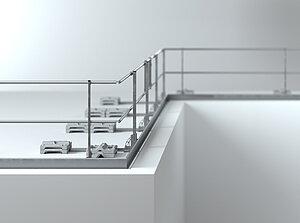
Guardrail System BARRIER
The variable railing system
The variable railing system. As collective protection, the BARRIER guardrail system eliminates the danger which results from an edge.
Summary
As was made clear in the individual sections, the selection of the correct fall protection system depends on various factors, including the specific work tasks, the structure of the equipment, and the environment. It is paramount that comprehensive risk assessment and planning is undertaken, in order to identify the most suitable fall protection systems for each specific situation, and thus to ensure the safety of the workers.
For all three types of power plants, it is also important that insulating protective clothing is worn in the proximity of electrical components, and/or that suitable insulation precautions are taken. In any case, thorough worker training in the correct use of the fall protection system and of anti-fall PPE is also of decisive importance.
INNOTECH acts as a highly proactive company in the area of fall protection systems for alternative energy sources. With our extensive product range and our planning service, we are happy to support you as a reliable partner for industrial safety in the development of renewable energy sources.
